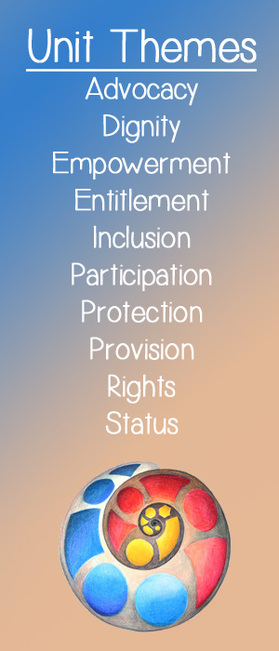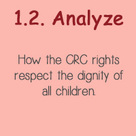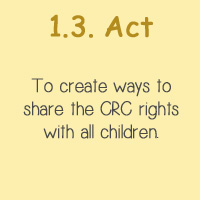Classroom Learning Activities
1. TEACHING TOLERANCE - A PROJECT OF THE SOUTHERN POVERTY LAW CENTER:
This is a comprehensive resource with multiple different activities for teaching children about dignity, fairness, compassion, and empathy.
This is a comprehensive resource with multiple different activities for teaching children about dignity, fairness, compassion, and empathy.
Relevant Convention Articles
Preamble
The States Parties to the present Convention,
Considering that, in accordance with the principles proclaimed in the Charter of the United Nations, recognition of the inherent dignity and of the equal and inalienable rights of all members of the human family is the foundation of freedom, justice and peace in the world;
Bearing in mind that the peoples of the United Nations have, in the Charter, reaffirmed their faith in fundamental human rights and in the dignity and worth of the human person, and have determined to promote social progress and better standards of life in larger freedom.
Article 1
For the purposes of the present Convention, a child means every human being below the age of eighteen years unless under the law applicable to the child, majority is attained earlier.
Article 2
1. States Parties shall respect and ensure the rights set forth in the present Convention to each child within their jurisdiction without discrimination of any kind, irrespective of the child's or his or her parent's or legal guardian's race, colour, sex, language, religion, political or other opinion, national, ethnic or social origin, property, disability, birth or other status.
2. States Parties shall take all appropriate measures to ensure that the child is protected against all forms of discrimination or punishment on the basis of the status, activities, expressed opinions, or beliefs of the child's parents, legal guardians, or family members.
Article 3
1. In all actions concerning children, whether undertaken by public or private social welfare institutions, courts of law, administrative authorities or legislative bodies, the best interests of the child shall be a primary consideration.
2. States Parties undertake to ensure the child such protection and care as is necessary for his or her well-being, taking into account the rights and duties of his or her parents, legal guardians, or other individuals legally responsible for him or her, and, to this end, shall take all appropriate legislative and administrative measures.
3. States Parties shall ensure that the institutions, services and facilities responsible for the care or protection of children shall conform with the standards established by competent authorities, particularly in the areas of safety, health, in the number and suitability of their staff, as well as competent supervision.
The States Parties to the present Convention,
Considering that, in accordance with the principles proclaimed in the Charter of the United Nations, recognition of the inherent dignity and of the equal and inalienable rights of all members of the human family is the foundation of freedom, justice and peace in the world;
Bearing in mind that the peoples of the United Nations have, in the Charter, reaffirmed their faith in fundamental human rights and in the dignity and worth of the human person, and have determined to promote social progress and better standards of life in larger freedom.
Article 1
For the purposes of the present Convention, a child means every human being below the age of eighteen years unless under the law applicable to the child, majority is attained earlier.
Article 2
1. States Parties shall respect and ensure the rights set forth in the present Convention to each child within their jurisdiction without discrimination of any kind, irrespective of the child's or his or her parent's or legal guardian's race, colour, sex, language, religion, political or other opinion, national, ethnic or social origin, property, disability, birth or other status.
2. States Parties shall take all appropriate measures to ensure that the child is protected against all forms of discrimination or punishment on the basis of the status, activities, expressed opinions, or beliefs of the child's parents, legal guardians, or family members.
Article 3
1. In all actions concerning children, whether undertaken by public or private social welfare institutions, courts of law, administrative authorities or legislative bodies, the best interests of the child shall be a primary consideration.
2. States Parties undertake to ensure the child such protection and care as is necessary for his or her well-being, taking into account the rights and duties of his or her parents, legal guardians, or other individuals legally responsible for him or her, and, to this end, shall take all appropriate legislative and administrative measures.
3. States Parties shall ensure that the institutions, services and facilities responsible for the care or protection of children shall conform with the standards established by competent authorities, particularly in the areas of safety, health, in the number and suitability of their staff, as well as competent supervision.
Online Resources and References
Cape Breton University Children's Rights Centre
Kids for Global PeaceWHYZZ - "A Course in Dignity for Young Children" (K-3):
This course is designed for educators of young children to engage them in the concept of dignity. It is a short story followed by discussion questions to uncover the meaning of treating others the way they would like to be treated. For more details, go here.
Equitas - International Centre for Human Rights Education is a non-profit organization that works for the advancement of equality, social justice and respect for human dignity in Canada and around the world through transformative human rights education programs. We equip local human rights defenders and educators to build more inclusive communities and to contribute to social and economic development goals through democratic participation.
Kids for Global PeaceWHYZZ - "A Course in Dignity for Young Children" (K-3):
This course is designed for educators of young children to engage them in the concept of dignity. It is a short story followed by discussion questions to uncover the meaning of treating others the way they would like to be treated. For more details, go here.
Equitas - International Centre for Human Rights Education is a non-profit organization that works for the advancement of equality, social justice and respect for human dignity in Canada and around the world through transformative human rights education programs. We equip local human rights defenders and educators to build more inclusive communities and to contribute to social and economic development goals through democratic participation.
|
Dignity - Little Things Make a Big Difference
|
A Path to Dignity: The Power of Human Rights Education -
A joint presentation of HREA, Soka Gakkai International, and the United Nations Human Rights Office of the High Commissioner. This movie demonstrates the power of an effective children's rights education that empowers children with knowledge of their rights, values in rights, and behaviours from rights. The result is children who embody values of non-discrimination and equality as they act to uphold these rights for all children. www.path-t-dignity.org |






